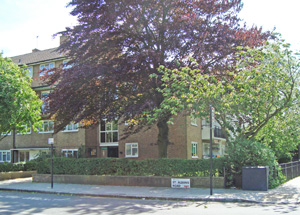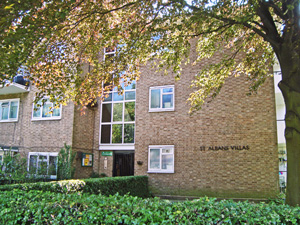Mayoress of St Pancras Home
for Sick Poor Children
for Sick Poor Children
Avalon, 1 St Albans Road, NW5 1QU
Medical
dates:
Medical
character:
Convalescent
The Mayoress of St Pancras Home
for Sick Poor Children opened in 1918 at No. 1 St Albans Road. It
had been founded by the Mayoress of St Pancras' Nursing Fund for Sick
Poor Children.
The Home had 18 beds for children who were ailing and needed observation, or better treatment than could be provided in their own homes. Most patients were convalescents after illness or were badly nourished, requiring feeding and special care. The Borough Council gave a grant of £500 a year towards the running costs of the Home. By 1919 the work had been recognised by the Ministry of Health, which paid a 50% grant in respect of maintenance expenditure.
The house, which also accommodated the necessary staff, had a large garden.
In 1920 some 108 children had been admitted and discharged, staying on average for about 41 days. Of these, 27 were aged under 2 years, 23 aged 1 year and 16 were babies under the age of 1; 17 were aged 3 years and 14 aged 4 years. Eleven were aged 5 years or over. During the year the Home was only open for 309 days. It had to close in March due to an outbreak of whooping cough, in April because of measles, and in October because of scarlet fever (as the children had been admitted during the incubation stage of these infectious diseases).
In 1923 some 83 children had been admitted, with an average stay of 43 days. Only 9 were in residence at the end of the year. Of the 90 who had been discharged, 21 left in good health, while 51 were much improved. Only 11 showed no marked improvement, but some had been sent home early in May and June, where there had been an epidemic of whooping cough at the Home.
Of the 83 admissions, 24 had debility and anaemia, 10 had rickets, 8 had tardy development, 4 had various nutritional disorders; 5 were admitted for other causes (unstated). Convalescent patients included those following pneumonia and bronchitis (15), measles and whooping cough (5), operation (9) and other conditions (3).
By 1926 the Borough Council grant had been reduced to £350. Some 104 children aged from 2 to 5 years had been admitted during the year, staying on average about 33 days. Only 16 showed no marked improvement.
In 1930 the age limit for admission was from 18 months to 5 years. An outdoor playground had been provided by the St Pancras Branch of the Dickens Fellowship.
The staff of the Home consisted of a Matron, an Assistant Matron, three probationers and three domestic servants. A laundry, equipped with electrically driven machinery, was attached to the Home.
In 1932 some 174 children had been admitted and discharged, staying on average for about 4 weeks. If they needed a longer period of convalescence or more skilled nursing, they were sent to various homes run by the Invalid Children's Aid Association (now I CAN). The Borough Council contributed to the cost of this, with some 36 children being sent away during that year.
By 1950 the Home had become the South Highgate Welfare Centre.
It closed on 17th October 1955 as the accommodation was felt to be unsatisfactory. The clinic sessions were transferred to the Kentish Town Welfare Centre in Raglan Street and to the Highgate New Town Clinic in Chester Road.
In 1960 a new centre - the St Albans Welfare Centre - opened on the ground floor of St Albans Villas.
The Home had 18 beds for children who were ailing and needed observation, or better treatment than could be provided in their own homes. Most patients were convalescents after illness or were badly nourished, requiring feeding and special care. The Borough Council gave a grant of £500 a year towards the running costs of the Home. By 1919 the work had been recognised by the Ministry of Health, which paid a 50% grant in respect of maintenance expenditure.
The house, which also accommodated the necessary staff, had a large garden.
In 1920 some 108 children had been admitted and discharged, staying on average for about 41 days. Of these, 27 were aged under 2 years, 23 aged 1 year and 16 were babies under the age of 1; 17 were aged 3 years and 14 aged 4 years. Eleven were aged 5 years or over. During the year the Home was only open for 309 days. It had to close in March due to an outbreak of whooping cough, in April because of measles, and in October because of scarlet fever (as the children had been admitted during the incubation stage of these infectious diseases).
In 1923 some 83 children had been admitted, with an average stay of 43 days. Only 9 were in residence at the end of the year. Of the 90 who had been discharged, 21 left in good health, while 51 were much improved. Only 11 showed no marked improvement, but some had been sent home early in May and June, where there had been an epidemic of whooping cough at the Home.
Of the 83 admissions, 24 had debility and anaemia, 10 had rickets, 8 had tardy development, 4 had various nutritional disorders; 5 were admitted for other causes (unstated). Convalescent patients included those following pneumonia and bronchitis (15), measles and whooping cough (5), operation (9) and other conditions (3).
By 1926 the Borough Council grant had been reduced to £350. Some 104 children aged from 2 to 5 years had been admitted during the year, staying on average about 33 days. Only 16 showed no marked improvement.
In 1930 the age limit for admission was from 18 months to 5 years. An outdoor playground had been provided by the St Pancras Branch of the Dickens Fellowship.
The staff of the Home consisted of a Matron, an Assistant Matron, three probationers and three domestic servants. A laundry, equipped with electrically driven machinery, was attached to the Home.
In 1932 some 174 children had been admitted and discharged, staying on average for about 4 weeks. If they needed a longer period of convalescence or more skilled nursing, they were sent to various homes run by the Invalid Children's Aid Association (now I CAN). The Borough Council contributed to the cost of this, with some 36 children being sent away during that year.
By 1950 the Home had become the South Highgate Welfare Centre.
It closed on 17th October 1955 as the accommodation was felt to be unsatisfactory. The clinic sessions were transferred to the Kentish Town Welfare Centre in Raglan Street and to the Highgate New Town Clinic in Chester Road.
Present status (May 2009)
The building, along with others in the street, was demolished and a new apartment block - St Albans Villas - built in its place by the Borough Council.In 1960 a new centre - the St Albans Welfare Centre - opened on the ground floor of St Albans Villas.

St Albans Villas (above and below) now occupies the site of the Home.

Geffen GH 1954 Annual Report of the Medical Officer of Health. London, St Pancras, 5.
Radford M 1936 Report of the Medical Officer of Health. London, St Pancras, 111.
Radford M 1938 Report of the Medical Officer of Health. London, St Pancras, 11.
Scott JA 1955 Report of the County Medical Officer of Health and Principal School Medical Officer. London County Council, 66.
Shadick Higgins T 1919 Report of the Medical Officer of Health. London, St Pancras, 62.
Sowden G 1923 Report of the Medical Officer of Health. London, St Pancras, 26.
Sowden G 1926 Report of the Medical Officer of Health. London, St Pancras, 21.
Sowden G 1930 Report of the Medical Officer of Health. London, St Pancras, 40.
Sowden G 1931 Report of the Medical Officer of Health. London, St Pancras, 40.
Sowden G 1932 Report of the Medical Officer of Health. London, St Pancras, 39.
Tracy SM 1962 Report on the Health of the Borough. London, St Pancras, 5.
Return to home page